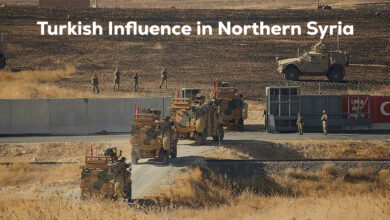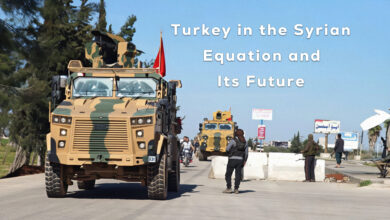Developments in the Syrian Crisis
From the Fall of Aleppo to the Collapse of the Ba'athist Regime

General Overview
On November 27, 2024, Hayat Tahrir al-Sham (HTS, formerly Jabhat al-Nusra) and allied jihadist factions launched a comprehensive surprise offensive on western Aleppo’s countryside, under the name Operation Deterring Aggression. This coincided with the collapse of local leadership within the Ba’athist regime, prompting mass withdrawals of its forces, officials, and supporters toward regime-held territories. Dozens of soldiers were left to face their fate—some defected, others were captured, and many were killed in battles or executed in the field.
Within four days of the offensive, all regime-controlled areas in Idlib and western Aleppo countryside were seized, and most districts of Aleppo came under the control of the attacking factions, except for Sheikh Maqsoud and Ashrafiyeh[1] neighborhoods. These areas remained under the protection of local forces. The offensive did not halt with the capture of Aleppo; it expanded southward toward Hama. However, by the eighth day, the pace of progress slowed as regime forces regrouped at the entrances to Hama, turning the city into a strategic defensive line. Despite this, the city soon fell into the attackers’ hands, opening the path toward Homs.
Simultaneously, Turkish-backed mercenaries launched their Dawn of Freedom operation on the Afrin and Shahba regions on November 30, 2024. However, they failed to carry out widespread looting, killing, kidnapping, and displacement of Kurdish civilians due to the resistance of the Afrin Liberation Forces. To protect civilians and avoid a repeat of the Shengal (Sinjar) catastrophe, the Syrian Democratic Forces (SDF), under U.S. guarantees, struck an agreement with the HTS on December 2, 2024, to create a safe passage for approximately 200,000 Kurdish civilians from Shahba and Aleppo’s countryside. Tens of thousands endured arduous and perilous journeys to reach safe zones in the eastern Euphrates region. However, thousands remain besieged by mercenaries conducting the so-called Dawn of Freedom operation.
During this period, Turkish-backed forces committed numerous violations against Kurdish civilians. Social media was flooded with images, videos, and reports confirming these abuses, revealing that Turkey’s military oversaw part of a campaign aimed at the eradication of Kurds in the area.
On December 7, 2024, the factions captured Homs following the regime’s withdrawal. The next day, the regime’s president and his aides left Damascus for an undisclosed location. By December 8, Damascus fell to a new coalition called Operations Room for the Liberation of Damascus, reportedly supported by the Free Syrian Army faction from the al-Tanf area. The regime’s power disintegrated rapidly across its remaining territories. Its leaders and personnel surrendered to the SDF in Hasakah, Qamishli, Deir ez-Zor, Mayadin, and al-Bukamal. Subsequently, its authority collapsed in the coastal regions, which had been its primary stronghold.
The End of an Era
Bashar al-Assad failed to preserve the legacy of his father. His last-minute appeals to Trump-aligned entities proved futile. Statements welcoming his regime’s fall emerged alongside the abandonment by his Russian and Iranian allies, who share responsibility for failing to resolve the regime’s issues with the Syrian people.
The timing, ambiguity, and rapid execution of these events, alongside the evolving political process in Syria, raise numerous questions about the strategy behind these operations, the forces enabling their swift success, and the long-term implications for both beneficiaries and those adversely affected.
Key Observations
Certain aspects deviate from initial expectations or appear unforeseen by political analysts. Identifying these critical elements may help construct a clearer understanding of these events and their potential repercussions. Key Observations on the Recent Developments in the Syrian Crisis
- Discrepancy in Resources and Weaponry:
The scale and quality of armaments, drones, and modern military vehicles possessed by the factions in northwestern Syria do not align with their limited financial resources. This is especially notable given that Idlib is under siege and has high poverty rates, with human rights organizations reporting 4.4 million people in need of humanitarian aid, 85% of whom reside in camps. Furthermore, many factions in the region are listed as global terrorist organizations. - Sophisticated Intelligence Capabilities:
The precision of intelligence, particularly regarding the regime’s command system and the identification of key officer locations through aerial drone reconnaissance, seems beyond the factions’ capacity. This observation does not diminish their strength but raises questions about external support. - Turkey’s Covert Role:
While Turkey refrained from openly acknowledging its involvement in the attacks, its intelligence operations were evidently active. Notably, over two months prior, the commander of Turkey’s land forces visited the area, and significant military reinforcements were sent to its bases in Afrin and other military posts in “de-escalation zones” established through the Astana framework brokered by Putin and Erdoğan. - Turkish-backed Dawn of Freedom Operation:
Turkey’s mercenaries launched the so-called Dawn of Freedom operation independently, accompanied by media fanfare, with a focus on targeting and terrorizing Kurds in the area to force their displacement. - Kurdish Civilians Facing Threats of Genocide:
The Kurdish population faced severe threats, compelling the Syrian Democratic Forces (SDF) to reach an agreement with Hay’at Tahrir al-Sham (formerly Jabhat al-Nusra), under U.S. guarantees, to open a safe corridor for 200,000 Kurdish civilians to move to safe areas in the eastern Euphrates region. Meanwhile, a series of violent attacks targeted the Manbij region. - Collapse of the Syrian Regime’s Command Structure:
The regime’s command system disintegrated rapidly, with minimal Russian and Iranian support in response. Bashar al-Assad was reportedly in Moscow, and key regime figures fled before the factions entered Aleppo, Hama, or Homs, leaving remaining forces to their fate. - Russia and Iran’s Inaction:
The conspicuous lack of ground and air support from Russia and Iran for the Syrian regime raises questions about their commitment to Assad’s survival. - Netanyahu’s Threats and Hezbollah’s Agreement with Israel:
The attacks occurred shortly after direct threats by Israeli Prime Minister Netanyahu against Assad and one day following Hezbollah’s acceptance of Israeli demands and signing of a ceasefire agreement. - Iraq’s Border Precautions:
The Iraqi army mobilized significant forces along the Syrian border, declaring readiness to confront “terrorism” emanating from Syria. Iraq’s National Security Advisor Qassem al-Araji issued a post stating, “Zainab will not be enslaved twice.” - Emphasis on Syria’s Sovereignty:
Several parties reiterated the importance of maintaining Syria’s territorial integrity and sovereignty as a unified state. - S. Denial of Involvement:
The U.S. officially denied any direct role in the operations[2]. - Preceding Political Summits:
These events followed two significant summits held on November 11, 2024: the Astana Summit, widely regarded as a forum for political and security deals, attended at a low level; and the Arab-Islamic Summit in Riyadh, attended by heads of state, including Erdoğan and Assad, and welcomed by Russia for its outcomes[3]. - Erdoğan’s Push for Normalization:
Erdoğan continues to press for normalization with the Ba’athist regime without preconditions. - The Emergence of Ahmed al-Sharaa (al-Jolani):
Ahmed al-Sharaa (Abu Mohammad al-Jolani) has emerged as a central figure in the new landscape. Despite being internationally wanted and surviving a Russian assassination attempt on December 2, 2024, he has made high-profile visits to Aleppo, Hama, Homs, and Damascus, projecting confidence in the region’s new security dynamics. - Mixed Human Rights Record:
The factions made efforts to project respect for human rights and international conventions, avoiding looting and publicizing these actions through videos, some poorly staged. Conversely, numerous videos documented humiliating treatment of prisoners and civilians, as well as field executions, particularly by Turkish-backed factions. - SDF Advances and Local Operations:
On December 6, 2024, the Syrian Democratic Forces (SDF) entered areas west of the Euphrates and established control over Deir ez-Zor, Mayadin, and Al-Bukamal, following the withdrawal of Ba’athist regime forces and Iran-backed factions. On the same day, local factions in Suwayda formed the “Battle for Resolution Operations Room,” taking control of the city and its countryside. Similarly, local factions in Daraa established the “Southern Operations Room” and gained control of Daraa and its countryside. Meanwhile, the “Free Syrian Army” faction based in Al-Tanf moved toward the desert region and appeared to have reached Damascus ahead of other forces. The Ba’athist regime lost Hama, Homs, and Damascus to the advancing factions. - Failed Attempts by ISIS and Ba’athist Remnants:
Groups affiliated with ISIS and remnants of the Ba’athists attempted to exploit the situation by raising independence flags, declaring their alignment with the “Deterring Aggression Operations Room,” and releasing videos implying their control over Deir ez-Zor. However, the direct communication channel between the SDF and the “Deterring Aggression Operations Room,” coupled with the latter’s refusal to recognize these groups, thwarted their attempts. The SDF quickly regained control of the situation.
The Dynamics of Changing Military Influence Among Syrian Local Forces
Many observers have compared the tactics used in the attack on Aleppo to those deployed in Ukraine’s assault on Russia’s Kursk[4] region or ISIS’s 2014 assault on Mosul. Overall, based on developments in the region since November 27, 2024, and relatively recent field data, several interpretations can be offered. While they may not be entirely precise, they directly relate to assessing the evolving security and political dynamics in the Eastern Mediterranean and, more specifically, within the context of the Syrian crisis.
It appears that what has been termed the “Deterring Aggression Operation” was managed by a high-level operations room, possibly linked to larger operational centers driving the broader Middle Eastern conflict. The role of the factions involved seemed limited to executing directives on the battlefield and in the media. If a deal or agreement existed, it likely involved senior officials in the Ba’athist regime, as a sudden withdrawal decision within a bureaucratic state system would require approval from the highest authorities.
This agreement may have been negotiated during the emergency Arab-Islamic summit held in Riyadh on November 11, 2024. Bashar al-Assad’s flight from Damascus on the night of its fall suggests the involvement of senior regime officers in the deal. These officers appear to have been instrumental in sharing information and providing coordinates of key locations, including those of Iranian Revolutionary Guard and Quds Force officers in Damascus, Aleppo, Homs, Deir ez-Zor, and southern Syria. They also seem connected to the formation of the so-called “Operation Room for the Liberation of Damascus[5],” which issued its first statement following the regime’s fall.
This context helps explain speculations about significant divisions within the Ba’athist regime among three factions: one aligned with Arab states, another with Russia, and a third with Iran[6]. It also clarifies why Russia and Iran were aware of the operation’s scale and strength but did not prioritize it during the concurrent “Astana 22” talks. These talks remain a focal point for Iran, which pushed for meetings between Turkish and Russian foreign ministers amidst ongoing events.
Assuming the agreement was part of the Riyadh summit, it might align with the “Arab Initiative,” first announced in 2021[7], aiming to sever the strategic bond between the Ba’athist regime and Iran. Israeli Prime Minister Netanyahu’s recent threats about this alliance reinforce this theory.
The Decline of Islamist Influence
These developments highlight a significant reduction in the role of the Muslim Brotherhood, which wields considerable influence in Turkish-occupied northern Syria. Notably, they were excluded from the “Deterring Aggression Operation” despite the involvement of Turkish-backed factions. This trend parallels efforts to curtail other Islamist groups, including Hamas, Hezbollah (in its Lebanese, Syrian, and Iraqi branches), and ISIS. Conversely, Abu Mohammad al-Julani (real name: Ahmed al-Shara) has gained notable media prominence, portraying himself as moderate, tolerant, and nationally Syrian—an approach unprecedented for him.
However, these shifts have reignited sectarian and ethnic hate speech. Some attacking factions displayed ISIS insignias or echoed its slogans, while Shiite extremists responded with inflammatory rhetoric.
U.S. Involvement and Response
Despite the U.S. officially denying involvement in the regime’s downfall, American officials mediated a safe passage for tens of thousands of Kurdish civilians to secure areas in northern and eastern Syria. They also sought to prevent ISIS from exploiting the emerging security vacuum[8]. Republican Senator Joe Wilson emphasized the right of Syrian refugees to return to their homes.
Meanwhile, the Ba’athist regime reportedly sought a deal with the Trump administration to reach a resolution. Trump’s response, however, was harsh, stating on Truth Social:
“Syria is in chaos, but it is not our friend. The U.S. should have no involvement. This is not our fight. Let it play out. Do not intervene.”
The U.S.-led coalition supported the SDF with air cover as they expelled Ba’athist forces, Iran-backed factions, and ISIS from areas west of the Euphrates.
Regional and International Repercussions
As the Iraqi army fortified its border with Syria, ostensibly to prevent terrorist infiltration, it simultaneously blocked supplies from Iraqi Shiite factions to the Ba’athist forces. Iraq also sought to distance itself from the conflict amidst international pressure on pro-Ba’athist sympathizers. Iraqi political maneuvers, such as hosting Ba’athist Foreign Minister Bassam Sabbagh and Iranian Foreign Minister Abbas Araghchi, alongside condemnations of Salafist factions, helped ease sectarian tensions domestically. Shiite cleric Muqtada al-Sadr’s opposition to Iraq’s involvement in the Ba’athist-opposition conflict further underscored this stance.
ISIS Maneuvers
ISIS appeared to monitor developments closely, blending with jihadist factions. Some of its members escalated tensions in Deir ez-Zor by hoisting independence flags and producing misleading footage implying their dominance. Meanwhile, the Ba’athist military collapse left key points in the Syrian desert unguarded, enabling ISIS to seize control quietly. This prompted the SDF and the coalition to expand west of the Euphrates, culminating in the regime’s surrender of Deir ez-Zor, Mayadin, and Al-Bukamal to the SDF under U.S. guarantees.
Recent operations[9] effectively disrupted the “Tehran-Baghdad-Damascus-Beirut” military land corridor, raising hopes it might evolve into a vital international trade route. This positioning could make the SDF the largest—or second-largest—military force in Syria.
In less than a week, Syria has reverted to a fragmentation reminiscent of its post-1920 French Mandate period: A “State of Aleppo” under HTS and allied factions, a “State of the Coast” with partial regime control, a “Druze State” in Suwayda linked to Daraa’s Southern Operations Room, a nebulous “State of Damascus”, and the “Jazira Region” governed by the Autonomous Administration of North and East Syria (AANES).
Militarily, six local powers dominate the country: The SDF, the “Deterring Aggression Operation Room”, the Turkish-backed “Dawn of Freedom Operation Room” mercenaries, the “Battle for Resolution” factions, the “Southern Operations Room” factions, and ISIS remnants. The dynamics among these actors will shape Syria’s next political chapter.
Potential Political and Security Outcomes Following the Fall of the Baathist Regime
- The Baathist regime has crumbled, unable to maintain control over Syria’s coastal areas. Attempts to reverse this trajectory appear futile, particularly as both Russia and Iran have visibly withdrawn their support. This collapse marks the end of agreements and frameworks that shaped Syria’s geopolitical dynamics during the years of conflict. A new political process is emerging, grounded in the realities on the ground.
Excluded groups, including the Autonomous Administration, political factions in Suwayda and Daraa, and Hayat Tahrir al-Sham (HTS), are poised to play significant roles in reconstructing the nation. This rebuilding will likely occur after a cooling of hostilities and the establishment of new alliances. The incoming Trump administration is expected to spearhead efforts to shape this new order in Syria and the broader region. Reports suggest that elements of Syria’s deep state, disillusioned with Assad’s pro-Russian and pro-Iranian policies, contributed to the regime’s downfall by facilitating the liberation of Damascus.
- The country’s future will be determined by international powers such as the United States, the UK, and Israel, along with agreements among pivotal Syrian figures like Mazloum Abdi, Ahmad al-Shara, and Sheikh Hikmat al-Hijri. Additional contributors might include regime defectors, Turkish-backed factions, and representatives from Hauran.
International agreements and sanctions—such as the Adana Agreement, Caesar Act, and those involving Russia and Iran—will likely be renegotiated. Crafting a new constitution in line with UN Resolution 2254 (2015) will pose challenges, particularly regarding the status of self-administration and occupied territories[10].
- Turkey continues its push for control over Kurdish regions in northern Syria but faces strong resistance, particularly in Manbij, where the Manbij Military Council inflicted significant losses on Turkish-backed forces. Broader regional discussions emphasize the need to protect Kurdish and minority communities from Islamist attacks, underlining the precarious situation these groups face. While international mediators strive to reduce tensions, Turkey’s ambitions in Manbij remain steadfast. A durable ceasefire between Turkey and the Syrian Democratic Forces (SDF), supported by enhanced economic and political cooperation and Turkey’s withdrawal from key territories under international guarantees, could stabilize the region.
- Turkey’s efforts to claim credit for the Baathist regime’s fall have faltered. Instead, Ahmad al-Shara (Abu Mohammad al-Jolani)’s sermon at the Umayyad Mosque has galvanized extremists aligned with Erdogan. Furthermore, Russia and Iran feel betrayed[11] by Turkey’s failure to dismantle HTS, marking a significant blow to their strategies in the Eastern Mediterranean.
- HTS’ transformation into a more moderate and Syrian nationalist entity could pave the way for improved relations with the Autonomous Administration, especially given their shared borders. However, Turkish backing of HTS for potential aggression against Kurdish areas, such as Sheikh Maqsoud and Ashrafiyeh, remains a concern. HTS’ alliances with groups hostile to Kurds and self-administration further complicate these dynamics.
- Turkey’s fixation on Aleppo stems from ideological imperatives. Erdogan’s administration views retaining control of Aleppo as crucial, extending this stance to territories like Afrin, Azaz, and Jarabulus. Domestic pressures and upcoming elections may drive Erdogan to seek further gains, including normalization talks with Syria’s new government.
- The establishment of “Southern Operations” in Daraa and “Decisive Battle” in Sweida signals a move toward autonomous governance in southern Syria. However, entrenched support for ISIS, the Baath Party, and drug traffickers presents ongoing challenges for neighboring Israel and Jordan. Enhanced financial resources and governance mechanisms will be critical to countering these threats and preventing a resurgence of extremist or regime-linked forces.
- Iran’s setbacks in Syria and Lebanon necessitate a reassessment of its regional strategy. Any agreements with the West to ensure its regime’s survival may require dismantling the Quds Force or the IRGC, alongside severing ties with Hezbollah, Palestinian factions, and the Houthis. In Iraq, Shia factions may pivot towards Arab nationalism, targeting Turkish bases and undermining Kurdish efforts to reclaim disputed territories.
- Issues like ISIS activity, Turkish violations, and resource exploitation paradoxically bolster the Autonomous Administration’s regional and international standing, fostering growing support for its governance.
- Syria’s new government will likely prioritize resolving the detainee crisis and pursuing accountability for human rights violations. A de-Baathification law, akin to Iraq’s, could be enacted to dismantle the party’s influence. The country’s recovery will hinge on securing agreements that align with Western interests and Israel’s national security.
In general, Syria is witnessing geopolitical exchanges among international, regional, and local powers, with extensions across the Middle East. These dynamics seem to have created an environment conducive to the resurgence of Salafists, albeit with a new political mindset. This could result in further violations against the Kurdish population in Rojava and may lead to the emergence of fragile security zones, particularly in remote areas near the frontlines of various Syrian factions. This, in turn, opens the door for ISIS cells to reemerge, alongside the deepening of fissures within the Iranian-Russian axis, the Alawite-Shiite bloc, and Turkey’s relations with both Russia and Iran. Upcoming developments on the ground are expected to unveil the political framework for the new Syrian state.
[1] The two neighborhoods were never fully under Syrian regime control, which had imposed a siege to force the residents into submission. They are currently governed by a local council following the commune system.
[2] U.S. Department of State; remarks during a UN Security Council briefing on Syria; published: December 3, 2024. https://usun.usmission.gov/remarks-at-a-un-security-council-briefing-on-syria-13/
[3] Bahrain News Agency; “Russia: Outcomes of the Arab-Islamic Summit Align with Our Firm Principles”; published: November 14, 2024. روسيا: مخرجات القمة العربية الإسلامية تنسجم مع توجهاتنا الثابتة
[4] In an unprecedented field development during a lightning offensive starting on August 6, thousands of Ukrainian forces crossed the border from Ukraine’s Sumy region into Russia’s adjacent Kursk region, supported by dozens of drones and armored vehicles. Within two weeks, they had achieved a historic feat, seizing vast territories in Russia exceeding the gains made by Russia in Ukraine over the past year.
[5] Al Sharq News; “‘Statement No. 1’ on Syrian State Television: ‘Liberation of Damascus and the Fall of Assad'”; published: December 8, 2024. “البيان رقم 1” على التلفزيون السوري: تحرير دمشق وإسقاط الأسد | الشرق للأخبار
[6] Based on ongoing observations, Farouk al-Sharaa represented the Arabist wing, Ali Mamlouk was aligned with the Russian axis, and Maher al-Assad was close to the Iranian camp
[7] For details of this initiative, see the report: Al Arabiya; “Jordan’s Initiative to Resolve the Syrian Crisis: Key Points”; published: June 27, 2023. “مبادرة الأردن” لحل أزمة سوريا.. تعرف على أبرز بنودها
[8] U.S. CENTCOM Commander General Michael Erik Kurilla: “Let there be no doubt—we will not allow ISIS to reorganize or take advantage of the current situation in Syria. Any organization in Syria cooperating with or supporting ISIS will be held accountable.” CENTCOM Arabic (@CENTCOMArabic); airstrikes conducted against ISIS camps in central Syria; published: December 9, 2024. X \ U.S. Central Command على X: “القيادة المركزية الامريكية تقوم بشن غارات جوية للقضاء على معسكرات تنظيم داعش في وسط سورية https://t.co/liP5PuVgVF”
[9] CENTCOM Arabic (@CENTCOMArabic); airstrikes conducted against ISIS camps in central Syria; published: December 9, 2024.
[10] For full details of the resolution. S_RES_2254(2015)-AR (1).pdf
[11] Several social media platforms close to Russia reported veiled threats by Russian philosopher Alexander Dugin, who is close to President Putin. Dugin stated: “Syria was a trap for Erdogan. He has committed a strategic blunder. He betrayed Russia. He betrayed Iran. He sealed his fate. Turkey’s end has begun. We supported you until now. From now on, you will repent…” Source:
MOSCOW NEWS (@M0SC0W0); published: December 9, 2024.




